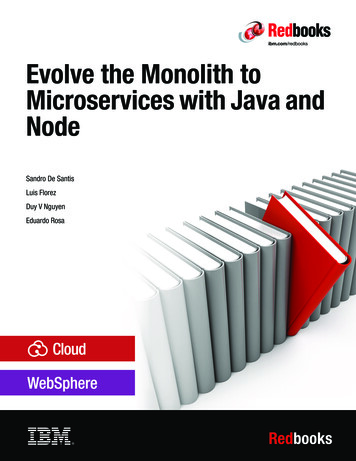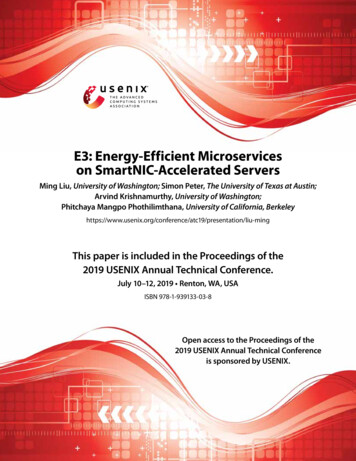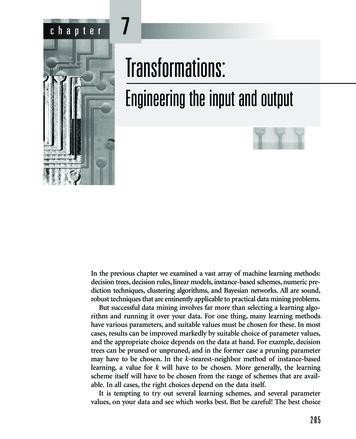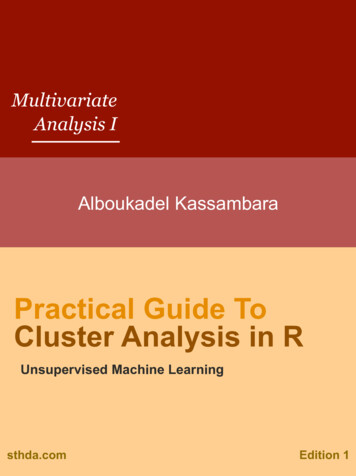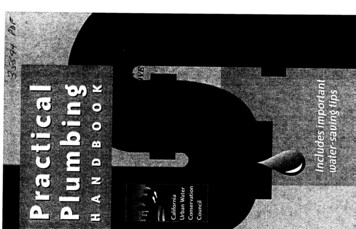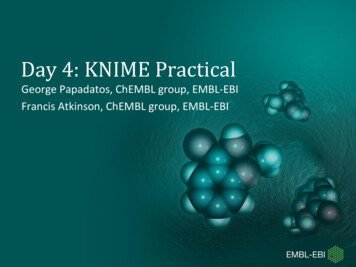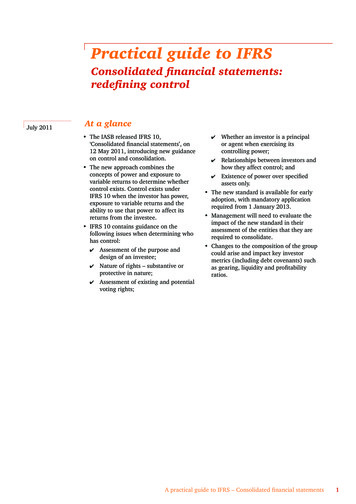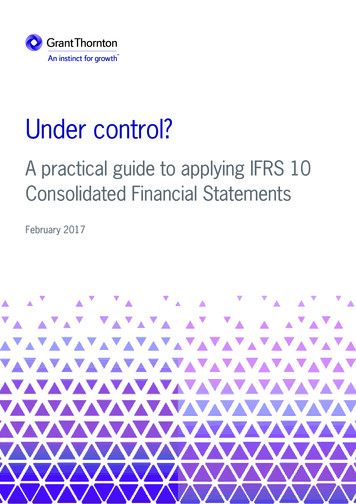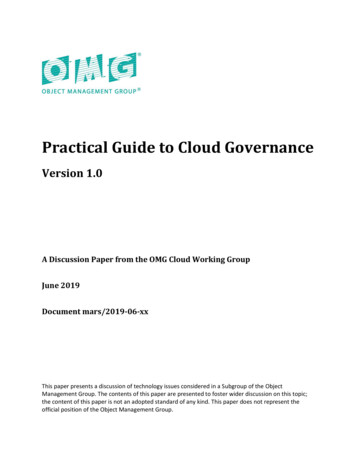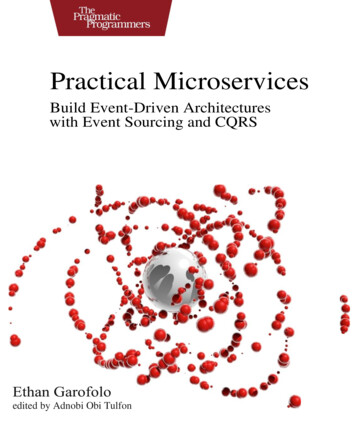
Transcription
Practical MicroservicesBuild Event-Driven Architectureswith Event Sourcing and CQRSedited by Adnobi Obi Tulfon
Practical MicroservicesBuild Event-Driven Architectures withEvent Sourcing and CQRSEthan GarofoloThe Pragmatic BookshelfRaleigh, North Carolina
Many of the designations used by manufacturers and sellers to distinguish their products are claimed astrademarks. Where those designations appear in this book, and The Pragmatic Programmers, LLC was aware of atrademark claim, the designations have been printed in initial capital letters or in all capitals. The PragmaticStarter Kit, The Pragmatic Programmer, Pragmatic Programming, Pragmatic Bookshelf, PragProg and the linkingg device are trade- marks of The Pragmatic Programmers, LLC.Every precaution was taken in the preparation of this book. However, the publisher assumes no responsibility forerrors or omissions, or for damages that may result from the use of information (including program listings)contained herein.Our Pragmatic books, screencasts, and audio books can help you and your team create better software andhave more fun. Visit us at https://pragprog.com.The team that produced this book includes:Publisher: Andy HuntVP of Operations: Janet Furlow ExecutiveEditor: Dave Rankin Development Editor:Adaobi Obi Tulton Copy Editor: Jasmine KwitynIndexing: Potomac Indexing, LLCLayout: Gilson GraphicsForsales,volumelicensing, andsupport, pleasecontact support@pragprog.com. Forinternational rights, please contactrights@pragprog.com.Copyright 2020 The Pragmatic Programmers, LLC.All rights reserved. No part of this publication may be reproduced, stored in a retrieval system,or transmitted, in any form, or by any means, electronic, mechanical, photocopying, recording,or otherwise, without the prior consent of the publisher.ISBN-13: 978-1-68050-645-7Encoded using the finest acid-free high-entropy binary digits.Book version: P1.0—April 2020
We are in bondage to the law in order that we may be free. Marcus Tullius CiceroCHAPTER 2Writing MessagesWhen last we left our intrepid hero, the maw of the monolith was closing around. As if in a badversion of Groundhog Day, teeth bearing the stench of a thousand years were about to laywaste to an exciting greenfield project, and another iteration of the horrific loop was about tobegin.But in that darkest moment, when hope itself had failed, yet one light still shone. Our herosummoned the wisdom of software design principles, unmasked the monster, and restored,let’s say, justice to the land.That’s pretty much the tale people will tell of your efforts in building Video Tutorials. Tongueless in cheek, in this chapter you are going to unmask the monolith. It turns out “monolith”doesn’t just mean “code that’s hard to work on.” A monolith does tend to be difficult, andyou’re going to uncover why that is so that you can prevent that great darkness from claimingyet another project. Eternal glory awaits.Unmasking the MonolithSoftware is easy to write, but hard to change. MVC CRUD frameworks lead you to monolithicarchitectures, which optimize for writing. Those quick results they deliver come at the cost ofadding a great deal of coupling into your project.1 Coupling is the enemy of change. Couplingis what makes it impossible to make a change in subsystem A without fear of breaking subsystem B, C, and D. If you rename that column in your users table, well, hope- fully you’ve clearedyour calendar for the weekend.That’s fine if you’re prototyping applications, but it’s a sandy foundation for long-lived systems.Recall our system map (see the figure on page 26) from the previous chapter.1.https://en.wikipedia.org/wiki/Coupling (computer programming)report erratum discuss
Chapter 2. Writing Messages 26Applications are just one part of an overall system. There arealso Components, Aggregators, andView Data to build and maintain. If you don’t remember what these different pieces are andwhat they do, refer back to our list on page 22.But what is the heart of a monolith’s coupling? What is it that makes some- thing a monolith?Is it a question of language? Framework? Database? Codebase size? Monorepo vs. polyrepo?How many servers the system is running on?Depending on where you land when searching in the blogosphere, those might be posed as theessential questions. Or you might read that “microservices” means “stuff running on differentmachines.” Or Docker. Surely, if you use Docker, you’re dealing with microservices. Right?Right?You landed here though, and you’re going to learn all throughout this book that while thosequestions are important, none of them has any bearing as to whether or not something is amonolith. You can build a service-based system with Rails, and you can certainly buildmonoliths with Docker. A monolith is a data model and not a deployment or codeorganization strategy.report erratum discuss
Trying to Compress Water 27Trying to Compress WaterRemember the videos table from the previous chapter?It has a mere six columns: id, owner id, name, description, transcoding status, andview count. Do these pieces of data really all belong together? Do they represent a single thing?Can you imagine asingle operation that simultaneously requires all six pieces of data? How manydifferent concerns are represented here?owner id is useful if we’re trying to make sure that someone trying to do something to thisvideo is allowed to—authorization. But how does that help us when putting the video in thevideo player that other users will see? It would be nice to see the owner’s actual name there,but this table doesn’treport erratum discuss
Chapter 2. Writing Messages 28even have that information. Finally, transcoding status has nothing to do with either ofthose. Transcoding a video happens in the background, and if a video isn’t ready for viewing,why would it show up at all for users who aren’t the owner?The thing represented by this table is an aggregation of many different con- cerns. Whichmeans that any changes to this table could potentially break each of those concerns. This willhappen every time you rely on a canonical data model2—the one representation of a systementity to rule them all and in the darkness bind them. You can try to force these data together,in the same way that you can try to compress some measure of water. It can be done, but onlyat the cost of considerable energy. That’s because they don’t want to be together.This data model is the monolith, and no change of language, framework, or deploymentstrategy can fix that. Nor does the blogosphere’s general advice in these situations.Extracting “Microservices”When you hit your productivity wall, the blogosphere is going to tell you to Just ExtractMicroservices. Okay. Here’s our fledgling system with a hypo- thetical users concern addedto the mix:All of these pieces being in the green box represents that their running on the same server.users and videos are run-of-the-mill MVC “models” that have a table of the same name insideof the big, honkin’ database sitting in the middle of it all. videos, of course, makes functioncalls to this users “model” nonical-data-model/report erratum discuss
Defining Services 29get data about users. Imagine this project scaling to all sorts of “models,” and then we hit theall-too-common “we can’t work on this anymore, so we print our resumes and go find anotherjob.”Or desperate to make it better we try to implement the blogosphere’s advice and just extractthe users and videos “microservices”:More green boxes, more problems. We’ve paid a price here. Two servers. Two databases.Those function calls from before? They’re HTTP calls now. It’s okay to pay a price to receivevalue, but what value did we receive here?Absolutely ,ifthisso-called“users” service goes down, it’sbringing the so-called “videos” service down with it because “videos” depends on “users.”“Videos” now has two reasons to fail. BOO!What you have in that image is not microservices.It is in every aspect still a monolith, only it is distributed now—a distributed monolith. Everyaspect of working on this system will be more difficult than it was before. Your operationalcosts just went up (!). What you used to be able to do with a JOIN in a database you have tore-implement in app code (!!). You now need expensive tooling and orchestration to make thiswork even in development (!!!).Simply putting a database table behind an HTTP interface does not produce a service, microor otherwise. So what does?Defining ServicesThe defining characteristic of microservices is autonomy. Nice word, but what does it mean inthis context?report erratum discuss
Chapter 2. Writing Messages 30First of all, let’s get back to calling them Components. Good. Now, Components don’t respond toquestions. We have things we ask questions of in software. They’re called “databases,” and theprocess of asking them something is called “querying.” Even if you stick a database behindHTTP, it’s still a database, architecturally speaking.Components don’t ask questions of anything else. If they did, they would depend on that thingand would no longer be autonomous. If you have to connect to something else to get data tomake a decision, then you are not autonomous.You might be saying, “That’s all well and good, but that sounds like the properties of both ablack hole and a white hole—no information in, no information out. Not only a paradox, butentirely useless in software.” There is a way, and that way is through asynchronous messages.Getting Components to Do ThingsAsynchronous messages are what make service-based architectures possible. We’ll just callmessages from here on, but they come in two flavors: commands and events.Commands are requests to do something. Maybe that’s transferring some funds, or maybethat’s sending an email. Whatever the desired operation is, commands are merely requests.The Component that handles a given com- mand chooses whether or not to carry it out.Components produce events in response to commands. Events are records of things that havehappened. That means whatever they represent, it’s already done. You don’t have to like it, butyou do have to deal with it.Commands and events, collectively messages, are moved around in the system via publishsubscribe, or pub/sub for short.3 In pub/sub, publishers publish data, and they’re not sure whosubscribes to it. Subscribers similarly don’t know who published the information theyconsume.When you write a Component, as you will in Chapter 9, Adding an Email Component, on page133, you document which commands your Component handles as well as which events yourComponent publishes. With those messages defined, interested parties can request yourComponent do some- thing and can also respond to the events your Component ��subscribe patternreport erratum discuss
Representing Messages in Code 31Representing Messages in CodeSo what does a message look like? We can represent them as JSON objects:{"id": "875b04d0-081b-453e-925c-a25d25213a18","type": "PublishVideo","metadata": {"traceId": "ddecf8e8-de5d-4989-9cf3-549c303ac939", data": {"ownerId": "bb6a04b0-cb74-4981-b73d-24b844ca334f", "sourceUri":"https://sourceurl.com/","videoId": "9bfb5f98-36f4-44a2-8251-ab06e0d6d919"}}This is a command you’ll define in Chapter 10, Performing Background Jobs withMicroservices, on page 157.At the root of this object we have four fields:idEvery message gets a unique ID, and we use UUIDs for them.typeA string and something you choose when you define your messages. When we said earlierthat events represent things that have happened, it’s the type that tells us what that thingthat happened was. And in the case of commands, the type tells us we want to havehappen.metadataAn object that contains, well, metadata. The contents of this object have to do with themechanics of making our messaging infrastructure work. Examples of fields we’llcommonly find in here include traceId, which ties messages resulting from the same userinput together. Every incoming user request will get a unique traceId, and any messageswritten as part of that user request will get written with that request’s traceId. If thereare any components that write other messages in response to those messages, then thosemessages will have the same traceId. In that way, we can easily track everything thathappened in the system in response to a particular user request. We’ll put this into actionin Chapter 13, Debugging Compo- nents, on page 207, which deals with debuggingstrategies. We will alsoreport erratum discuss
Chapter 2. Writing Messages 32commonly have a userId string, representing the ID of the user who caused the messageto be written.dataA JSON object itself, and the “payload” of the event. The contents of a message’s datafield are analogous to the parameters in a function call.You can tell that this event is a command because the type is in the imperative mood. This is aconvention we will always follow. Since a command is a request to do something, its type is inthe imperative mood. This is in contrast to the event that might get generated in response tothis command:{"id": "23d2076f-41bd-4cdb-875e-2b0812a27524","type": "VideoPublished", "metadata": {"traceId": "ddecf8e8-de5d-4989-9cf3-549c303ac939", data": {"ownerId": "bb6a04b0-cb74-4981-b73d-24b844ca334f", "sourceUri":"https://sourceurl.com/","videoId": "9bfb5f98-36f4-44a2-8251-ab06e0d6d919"}}Notice the type on this event is in the past tense. That’s because events are things that havealready happened.Naming MessagesGiving types to our messages is the most important of the engineering work we’ll do. As weadd features to our system, we’ll use messages to represent the various processes the systemcarries out. The preceding messages come from the video cataloging process we’ll build inChapter 10, Performing Background Jobs with Microservices, on page 157.We come up with types for the messages in collaboration with our company’s business team.Message types are named after the business processes they represent. Furthermore, we selecttypes using language familiar to experts in the domain we are modeling. This is not somethingwe can do alone as developers.If we were modeling banking, we might have messages like TransferFunds,AccountOpened, and FundsDeposited. We absolutely will not have types that contain “create,”“update,” or “delete.” We’re purging that CRUD from our vocabulary.report erratum discuss
Storing State as Events 33Storing State as EventsUp to this point, this concept of commands and events may be familiar. You may have alreadyused technology such as Apache Kafka4 to have components communicate via events. We’regoing to take it further though.You may receive a command like PetPuppies, a command that should neverbe rejected. Whena command is processed, the output is one or more events, such as PuppiesPet. If we wantedto know whether or not the puppies have been pet, how could we tell? Take a moment andthink about it All we’d have to look for is that event. Instead of treating the messages as transientnotifications, discarding them when we’re done, we save them. Then we can constitute andreconstitute current state or state at any point in time to our heart’s content. This is eventsourcing—sourcing state from events.If you’ve done MVC CRUD apps, then you’re probably used to receiving incoming requests andthen updating one or more rows in a database. At any given point, you were storing the currentstate of your system, having discarded all knowledge of how the system got into that state.Because we’re already going to use messages to communicate between portions of oursystem, why not keep them around? Then we could use the events to know what the state ofour system is now, and at any point in the past.Storing Messages in StreamsOne last note about messages before we begin writing them. When we start writing messageson page 36, we’ll organize them into what we call streams. Streams group messages togetherlogically, usually representing an entity or process in your system. Within a stream, messagesare stored in the order they were written.For example, Video Tutorials users will have an identity. We’ll explicitly model that identity inChapter 6, Registering Users, on page 83. All the events related to a particular user’s identitywill be in the same stream, and those are the only events that will be in that stream. Using thenaming conventions of the Eventide Project,5 a Ruby toolkit for building autonomousmicroservices, we call this type of stream an entity stream. We use UUIDs6 as identifiers in oursystem, specifically version 4 UUIDs, and so a natural name for one of these user identity streamswould be ttps://en.wikipedia.org/wiki/Universally unique identifierreport erratum discuss
Chapter 2. Writing Messages 34While any part of the system is free to read the events in such a stream, a property we’ll usein Chapter 8, Authenticating Users, on page 119, an entity stream only has a single writer.Here is a pair of such identity streams:There are other kinds of streams, though. If all goes as planned, Video Tuto- rials will havemore than one user, each with a stream of the form identity-UUID. Every event in such an entitystream is also part of the identity category stream. To get the category stream that an entitystream belongs to, just take every- thing to the left of the first dash. So for identity-81cb4647-12964f3b-8039-0eedae41c97e, identity is the category. The identity category stream containsevery event written to every identity in our system.We talked about commands on page 30, and commands are also written to streams. Theyaren’t written to entity streams, though—they are written to command streams. In the case ofthis identity Component, we’ll write to streams of the form 7e. This is an entity command stream, and it only contains commandsrelated to a particular entity. What is the category of this stream? Is it the same as the entitystream from before? Again, to get a category from a stream, take everything to the left of thefirst dash. For this entity command stream, that gives us identity:com- mand, which is not thesame as identity. So no, entity streams are not in the same category as entity commandstreams.Streams, like messages, don’t get deleted. Messages are added to them in an append-onlymanner.Now, if there’s anything we can take from the 1984 Ghostbusters film, crossing the streams isBad and continued abstract talk about streams will likely lead to that. Now that we have thebasics of messages, let’s get to a concrete example and resolve the cliffhanger we started onpage 20.report erratum discuss
Defining Component Boundaries 35Defining Component BoundariesStream boundaries are Component boundaries. If we have a stream category such as identity,what we’re saying is that there’s going to be a single Compo- nent authorized to write tostreams in the identity category. Those are Compo- nent boundaries. Similarly, if we havecommand streams in the category identity:command, only that same Component isauthorized to handle those commands. These strict rules are part of avoiding monoliths. In amonolith, anyone can add columns to the users table and make updates to its rows. Not so inour architecture! The lack of these boundaries are why we can’t just Extract Microservices from a monolith. As you’ll see when we look at dis- tributing our system in Chapter 12,Deploying Components, on page 195, it’s precisely these boundaries that allow us to extractthings.Sometimes, although not in this book, a Component will own more than one entity. This israre, and it also doesn’t break our rule in the previous para- graph. A category has a singleowner, even on the rare occasions that a par- ticular owner happens to own another category.Recording Video ViewsHow are we going to record that a video was viewed? Since we’re not going to just use an MVCCRUD-style database table, it stands to reason that we’re going to write a message. Shouldthat be an event or a command?Questions are best answered by going back to fundamental principles. In our initial talks withthe business team, one of the longer-term (read: outside the scope of this book) visions is tohave users buy memberships to see premium content, and the creators of that content wouldget paid based on how many times their videos were viewed. So we know an event eventuallyneeds to be written, and since we’re recording that a video was viewed, VideoViewed seemslike a good type for this kind of event.The next question then, who writes that event? Should the record-viewings application writeevents directly, or should it write commands that some Component picks up and handles? Wepreviously discussed on page 33 how a given event stream is populated by one and only onewriter. So far, it could go either way.Let’s say that we have the application write the events and that it writes to streams of theform viewingX, where X is a video’s ID. Are we capturing the necessary state? Check. Is thereonly a single writer to a given stream? Check. So far so good.report erratum discuss
Chapter 2. Writing Messages 36What if we wanted to run potential video views through some sort of algorithm to detect fakeviews before committing them to system state? Obviously none of our users would ever dothat, but, you hear stories. Investors like to know we’ve addressed this kind of thing, andcontent creators would want to know the view counts are legit.That seems like a bit much to put into a request/response cycle and something that we wouldwant to put into a Component. That Component would currently do nothing besides receiving,say RecordVideoViewing commands, and writing VideoViewed events. We don’t need tosupport this right now, so why take on that extra burden?The only reason to do so would be if this choice affects long-term maintain- ability. Does it? Ifwe had the application write the viewed events and later decided to move this into aComponent, what would we need to change?1.Refactor the Application to write a command to a command stream rather than an eventto an event stream.2.Write the Component.We’d have to do step 2 anyway, and step 1 doesn’t sound that hard. If we were doing thisCRUD style, we might have had to set up a different API to call into with the video view. We’dhave the same issue where verifying the view takes too long to put into a request/responsecycle, so that API would likely have done some sort of background job. When it’s done withthe verifi- cation, maybe it would make another call into our application to record the result ofthat verification? Or we modify our application to pull from a different database? Or we directlycouple our application to that API via a shared database table? Those all sound like messesfrom a design perspective, let alone the operational concerns of having to make two networkhops. With a pub/sub flow that stores state as events and makes sure a given event stream onlyhas a single writer, we’re able to proceed confidently in the short term without settingourselves up with a costly refactoring later.Let’s not worry about the Component right now and just have the Application record videoviewings. We’ll get to our first Component soon enough in Chapter 6, Registering Users, onpage 83.Writing Your First MessageOkay, when we left the record-viewings application, we were in the function that would recordthat a video was viewed. Here’s where we left off:report erratum discuss
Writing Your First Message ion createActions ({ db}) {function recordViewing (traceId, videoId) {}return {recordViewing}}We decided on page 35 that we’ll use VideoViewed events to record video views. We’ll writethese events to streams of the form viewing-X, where X is the video’s ID. So all we need to doin this function is build the event we’re going to write and then write it to the Message Store:The Code Directory Has ChangedFrom this point going forward in the book, the code is in thecode/video-tutorials/ folder.If you’re using Docker for the database, be sure to stop the con- tainer for thefirst-pass folder and switch to code/video-tutorials and re- run dockercompose rm -sf && docker-compose x.jsfunction createActions ({messageStore❷}) {function recordViewing (traceId, videoId, userId) {const viewedEvent {id: uuid(),type: 'VideoViewed',metadata: {traceId,userId},data: { userId,videoId}}const streamName viewing- {videoId} ❸return messageStore.write(streamName, viewedEvent)❹}return {recordViewing}}report erratum discuss
Chapter 2. Writing Messages 38❶ First of all, notice that we’ve taken out the reference to the db and replaced it with amessageStore reference. We’re writing an event and not updating a row in a videostable.❷ Then we construct the event. It’s just a plain old JavaScript object that can be serializedto JSON. You’ll notice the fields we mentioned on page31. There isn’t that much to an event.❶ Next, we construct the name of the stream that we’re going to write this event to.❹ Finally, we actually call messageStore.write to write the event. That function takes thestreamName that we want to write to and the message we want to write.There’s one last change we need to make in this file. In the top-level function we also need tochange the db reference to gs/index.jsfunction createRecordViewings ({messageStore}) {const actions createActions({messageStore})// . rest of the body omitted}The top-level function receives messageStore and passes it along to actions.(Re)configuring the Record-Viewings ApplicationAnd we also have a change to our configuration to make. We need to pull in the MessageStore, instantiate it, and pass it to the record-viewings application:video-tutorials/src/config.js// .Line 1const createPostgresClient require('./postgres-client') constcreateMessageStore require('./message-store') functioncreateConfig ({ env }) {-510-const knexClient createKnexClient({connectionString: env.databaseUrl})const postgresClient createPostgresClient({ )const messageStore createMessageStore({ db: postgresClient })const homeApp createHomeApp({ db: knexClient })const recordViewingsApp createRecordViewingsApp({ messageStore })report erratum discuss
Hanging a Lantern 39return {// .15-messageStore,-}-}Line 2 requires the code that will create our database connection to the Message Store, and line3 requires our Message Store code. We set up the database connection at line 8 by giving itthe connection info we get from the environ- ment. We’ll add that to env.js and .env is just amoment. Line 11 then instanti- ates the Message Store by passing it the postgresClientreference. Line 14 passes messageStore to instantiate the recordViewingsApp, and then we addmessageStore to the config function’s return value at line 17.A quick change in s {// AGE STORE CONNECTION STRING')}And be sure to add the corresponding value to .env:MESSAGE STORE CONNECTION STRING postgres://postgres@localhost:5433/message storeMake sure to put that on a single line. So, good to go, right?Hanging a LanternIn showbiz, when writers call attention to glaring inconsistencies, that’s called “hanging alantern on it.” We have one, ah, slight problem. We don’t actually have the Message Storecode yet. Let’s punt that to the next chapter because this one is already pretty long, and we’vecovered a lot in it.What You’ve Done So FarYou unmasked the monolith. You learned that monoliths are data models and that they speedup the near term at the expense of the long term by introducing high levels of coupling. Youalso learned that the most commonly recommended methods for dealing with this couplingdon’t actually do any- thing to address the coupling.Then you got your feet wet with the basics of message-based architecture. Messages are whatmake autonomous microservices possible, and autonomousereport erratum discuss
Chapter 2. Writing Messages 40microservices are what make long-term productivity possible. This was no small amount oflearning.Taking those principles then, you came back to our problem at hand—how do we record videoviews without writing ourselves into an inescapable corner? You learned about streams andconcluded the chapter by writing a VideoViewed event to a stream in the viewings category.You stepped into a whole new world.Aside from building the mechanics of the Message Store, which we’ll start in the next chapter,being able to analyze business processes and model them as messages is the most importantskill you can acquire. That’s where the real engineering is done. To that end, choose someworkflow that exists in the project you’re currently working on. Instead of thinking of it inCRUD terms, can you model it as a sequence of events? Strike create, update, and delete fromyour vocabulary, and state what your current project does in terms that non-developers woulduse. Does it get you thinking differently about the project? Does it reveal holes in yourunderstanding?Lanterns are great and all, but we need something to store our messages. As we continue thejourney to record video views and display the total view count on the home page, our next stepis to go from mythical Message Store to actual Message Store. You ma
trademark claim, the designations have been printed in initial capital letters or in all capitals. The Pragmatic StarterKit,ThePragmaticProgrammer, Pragmatic Programming, Pragmatic Bookshelf, PragProg and the linking g device are trade-
